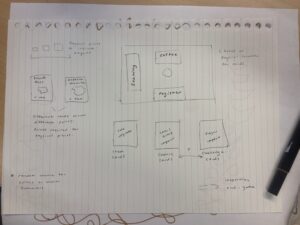
How might being in the deception role change a person’s playstyle?
It is important to question how changing roles will impact the way a player goes about the game in order to determine if an imbalance exists that may put certain roles at a disadvantage. For example, if the deceiever’s card takes more time to read than other players, it may become obvious which players have certain roles. Deception games are more fun when there is a challenge element that makes deduction reasoning necessary to win, and understanding playstyle may help us as designers adjust the rules to adhere to this. To answer this question, we will likely workshop different rules and types of play for each role. I anticipate we will need a lot of drafts and have to play through the game many times ourselves until we feel it is adequately balanced.
How do we make the game equally fun and engaging for players in all roles?
Every player should be actively engaging in some task or deduction, with the implementation of the former adding an element of engagement. For example, in the popular deduction game Among Us, even those not tasked with the deception role have tasks they need to complete during the game in order to progress or win. By making all players engaged and involved, everyone has fun, which is necessary to creating a good game! This will also involve many interactions of the game, playing through it ourselves, and asking others to play it for or with us. As designers, we have a bias of thinking our idea is fun – naturally we assume our game will be fun for other players – making it important to playtest with outsiders to ensure others feel the same.
How many cards should each player be allowed to hold at once?
As a card game it is important to consider how changing the minimum/maximum number of cards a player may have at once changes the game. If a player has four options for how to help the team, it is unlikely that they will all have negative consequences, but if each player only has two options, the probability of them both being bad increases slightly. The maximum number of cards may indicate to other players who is the deceiver, so as a deception game this is likely one of the most important rules to implement. To prototype this, we will likely have to play the game ourselves multiple times, adjusting maximum/minimum card count for runthroughs to determine what worked well. I anticipate our “item” cards requiring a small minimum, where the chance cards are not really impacted by maximum limits.
How does the design of cards appeal to players aethetically?
We want to game to be visually appealing while adhering to design principles. While we want the cards to focus on the images in the center, it is important for the information on the cards to be readable – particularly the point values – and for the design of the board to be intuitive to play. We will likely prototype a number of font and image styles and sizes before determining which one we like the most, and I anticipate sizes similar to those found in games like Exploding Kittens will be the most appealing for our game.



